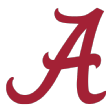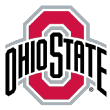There are many unique things about the 2020 college football season, but at the very top, almost nothing has changed.
The sport is still dominated by three teams: Alabama, Clemson and Ohio State. Alabama or Clemson has appeared in all six previous CFP fields, while Ohio State is aiming for its fourth appearance and first in back-to-back seasons.
Clemson's loss Saturday night at Notre Dame shifts the picture a bit. Notre Dame, which rallied late to force overtime and outlasted Clemson in the second extra session, showed it belongs, at least for now, in the upper crust. So does Clemson, though, as the Tigers nearly pulled off the win despite not having starting quarterback Trevor Lawrence or several key defenders. Clemson also emerges from the Notre Dame loss with some positives, none bigger than backup quarterback D.J. Uiagalelei, who passed for 439 yards, the most ever allowed by Notre Dame.
The first CFP rankings come out in 15 days. Barring a major upset, these four teams will lead the rundown.
Here's a breakdown of the top four, with help from coaches who have scouted or faced each squad.

Alabama Crimson Tide
AP ranking: 1
Up next: LSU (road), Kentucky (home), Auburn (home)
Allstate playoff predictor: 90.5% chance to make CFP, 39% to win national title
Alabama has the strongest profile, when factoring in wins over both Texas A&M and Georgia, by a combined 45 points. The program's pivot to offense is complete, solidified by Nick Saban's recent comments to ESPN's Chris Low that offense is now more important than defense in today's game.
There's seemingly no way to stop the Tide offense. Even Georgia, which boasts excellent personnel at all three levels on defense, surrendered 31 points in the final 33:06 of a 41-24 loss to Alabama, which finished with 564 yards and 33 first downs, averaging 7.4 yards per play. Alabama certainly will miss wide receiver Jaylen Waddle (557 yards, 22.3 yards per reception, four touchdowns), but coaches don't expect the unit's overall production to slow much.
"With Waddle [out], they'll take a little more time to score 42 points as opposed to two quarters," an SEC assistant said. "But they'll run roughshod. If they don't play Georgia in the SEC championship game, they'll blow out whoever they play."
That team likely will be Florida, which beat depleted Georgia on Saturday in Jacksonville. Unlike Georgia, Florida has the type of offense that could give Alabama trouble, much like Ole Miss did on Oct. 10, when the Rebels piled up 48 points and 647 yards in a 15-point loss. Florida averages 42.4 points and 495.4 pass yards per game. Quarterback Kyle Trask is a Heisman Trophy contender (1,815 pass yards, 22 touchdowns, three interceptions), while tight end Kyle Pitts is the clear favorite for the Mackey Award (414 receiving yards, eight touchdowns).
An SEC coach said Trask, Pitts and wideout Kadarius Toney (339 receiving yards, six touchdowns) are as good as any three from Alabama right now.
"The Alabama that beat Georgia still beats Florida," an SEC assistant said. "They'll get more stops than Florida would. The question will be: What can they be on offense against Florida without Waddle?"
Sophomore receiver John Metchie III is emerging as a strong complement to top wideout DeVonta Smith, putting up Waddle-like numbers (517 yards, 21.5 yards per reception, three touchdowns). But he also should start to see more double-teams, coaches said, as defenses no longer have to devote resources to both Smith and Waddle.
Alabama can lean more on a rushing game that has been Najee Harris-centric so far -- Harris (124 carries) has 87 more carries than anyone else and accounts for 714 of the team's 1,054 rushing yards -- but could broaden given the depth at running back.
Then again, quarterback Mac Jones has been so good that Alabama will continue to attack defenses with downfield passes. Among teams that have played four games or more, Alabama leads the FBS in yards per pass attempt at 11.8. Jones is completing 78.5 percent of his passes with 16 touchdowns and only two interceptions in 177 attempts. Jones plays behind most likely the nation's best offensive line, where all five starters have started every game.
"When he's able to see it and is not pressured and he's not running around for his life, he's really good," an SEC assistant said. "The confidence building of, 'You guys are going to protect in front of me, and I can take a little bit more time to make sure I'm right in what I'm seeing,' that helps."
Alabama's defense doesn't perform like the lockdown units that defined the national championship squads of 2009, 2011 and 2012. Given the trajectory of Alabama's offense, though, the defense simply needed to be better than last year, when it wasn't great in several key categories (rushing, percentage of plays of 10 yards or longer allowed, third-down conversions).
The group is showing signs of improvement, especially at linebacker, a position depleted by injuries in 2019. Dylan Moses' return provides leadership and production (team-high 50 tackles, 5.5 tackles for loss, one interception), but coaches really like the improvement of Christian Harris, who had to start 12 games as a true freshman last year. Alabama's largely new-look secondary is getting a boost from freshman Malachi Moore, while freshman Will Anderson adds another pass-rushing threat at linebacker.
"Alabama's kind of like what LSU was on defense last year, just OK," an SEC offensive assistant said. "Their front's very average. Linebacker, they're good. They're solid on defense."

Notre Dame Fighting Irish
AP ranking: 2
Up next: Boston College (road), North Carolina (road), Syracuse (home)
Allstate playoff predictor: 46.4% chance to make CFP, 5.7% to win national title
The Fighting Irish usually are not discussed in the same terms as Alabama, Ohio State and Clemson, but their performance Saturday night could change things. While Notre Dame's roster might lack as much high-end talent as the other three, it has certain areas that shine, especially around the line of scrimmage.
The offensive line and tight end groups stand out. Notre Dame protected quarterback Ian Book well against Clemson (two sacks), and created enough running room, as Kyren Williams opened the game with a 65-yard touchdown run and the Irish finished with 209 rush yards on 41 carries. Although Notre Dame employed a more aggressive approach toward downfield passes (more on this later), coach Brian Kelly never wanted to steer far away from the run, especially down the stretch and into the overtimes.
"They are so good up front," an ACC defensive coordinator said. "They look like a bunch of 35-year-old men out there. They're old. You can't throw anything new at them. They've seen it all, they've played so many snaps. You can't try to do some funky s--- to try to catch them off guard."
Notre Dame starts four seniors and a junior on the line, including two fifth-year players in tackle Liam Eichenberg and guard Tommy Kraemer, combining for 142 career starts (second-most nationally). "Really talented," an ACC head coach said. "The O-line is legit." Tight end also jumps out with senior Brock Wright, junior Tommy Tremble and freshman Michael Mayer, who leads the team with 20 receptions.
Coaches still have questions about the wide receivers and Book's ability to consistently attack downfield.
"They don't have the outside receivers," a Power 5 coordinator said. "They have the tight ends."
Book and his wideouts took a step against Clemson, as first-year playcaller Tommy Rees repeatedly called downfield passes. The strategy paid off as Javon McKinley had receptions of 45 and 28 yards, and Avery Davis had the play of the night, a 53-yarder in the final minute of regulation to set up the tying touchdown. Book has eclipsed 300 pass yards in two of his past three games, matching his total from all of 2019.
"We're at that point now where when those plays are called," Kelly said last week, "those guys are going to win one-on-one matchups."
Notre Dame remains largely driven by its run game and its defense, which forced turnovers on consecutive possessions against Clemson, scoring on one, and effectively shut down the nation's best running back in Travis Etienne (18 carries, 28 yards). Linebacker Jeremiah Owusu-Koramoah (2.5 tackles for loss, forced fumble, 26-yard touchdown return) showed why he's one of the nation's best defenders.
Safety Kyle Hamilton also belongs in that category, and the lineup is filled with other solid players, such as Daelin Hayes and Shaun Crawford. Coordinator Clark Lea runs a creative and effective scheme, especially with blitzes.

Ohio State Buckeyes
AP ranking: 3
Up next: Maryland (road), Indiana (home), Illinois (road)
Allstate playoff predictor: 73.6% chance to make CFP, 27.2% to win national title
The Buckeyes have the most limited profile with just three games, against opponents with a combined record of 1-7. They have trailed for all of five minutes and hold a 139-69 edge in scoring margin. But any objective analysis of Ohio State reveals a national championship contender.
"They've got dudes everywhere," a Big Ten assistant said. Quarterback Justin Fields is performing at an even higher level than he did in 2019, when his numbers -- 3,273 passing yards, 41 touchdowns, 3 interceptions, 67.2% completion rate and 484 rushing yards -- would normally have resulted in the Heisman Trophy. Fields has just 11 incomplete passes out of 83 attempts in three games, several of which were drops.
Fields is completing 86.7% of his attempts with 11 touchdowns and no interceptions, while averaging 302.7 pass yards through the first three games.
"Best player in the country," a Big Ten assistant told me Saturday night.
His accuracy is staggering: 94.5% of his attempts have been catchable, and only 3.6% have been off target.
"He knows he can be better in learning the game and recognizing coverages, getting protections right and going through his reads quickly and fundamentally," a Big Ten coordinator said, "staying clean with his drops so the ball's out on time."
Ohio State boasts two dynamic wide receiver threats in Chris Olave and Garrett Wilson, while Buckeyes coaches are expecting big things from younger players such as Jaxon Smith-Njigba, Julian Fleming and Gee Scott Jr. Tight end depth also is a strength for Ohio State: Jeremy Ruckert had two touchdown catches against Penn State and another Saturday against Rutgers, while Luke Farrell and Jake Hausmann are capable targets and blockers.
The run game is an area to monitor, and possibly an area of concern. Ohio State clearly misses J.K. Dobbins (2,003 rush yards, 21 touchdowns in 2019). Power back Master Teague III and Oklahoma transfer Trey Sermon aren't putting up overwhelming numbers, as both average less than five yards per carry. Although Fields can be a gifted runner, Ohio State wants to limit his carries and reduce the injury risk.
"That's the biggest difference I see," a Big Ten coach said of Ohio State's run game. "Fields is really special, and the receivers, that's the strength of their team."
Ohio State's defense entered the season with question marks after losing two of the top three players selected in the 2020 NFL draft -- defensive end Chase Young and cornerback Jeff Okudah -- as well as talented co-coordinator Jeff Hafley. As Big Ten Network analyst Gerry DiNardo told me before the season, "Chase was such a major factor. People were watching him like they were watching a tailback. He had that much impact on the game."
But Ohio State is finding new playmakers up front, including defensive tackle Tommy Togiai, who recorded three sacks in the Penn State win. A veteran linebacking corps leads the unit, and coordinator Kerry Coombs, who returned to the Ohio State staff after two years with the Tennessee Titans, has implemented new wrinkles to the scheme.
"It's different, and it's got to be," a Power 5 coach said. "[Coombs has] got to call what he knows. You can't fix something that's not yours. He'll crush it there. It's just going to take a little time. They're young."
A concern here is the lack of playmaking. Ohio State has only three takeaways and recorded only one sack against Rutgers.

Clemson Tigers
AP ranking: 4
Up next: Florida State (road), Pitt (home), Virginia Tech (road)
Allstate playoff predictor: 45% chance to make CFP, 10.6% to win national title
Despite Saturday's loss, there's still a lot to like about Clemson, especially when Lawrence and others return to the field. Although Clemson's defense effectively limited touchdowns for most of the Notre Dame game, the absences at its core -- linebackers James Skalski and Mike Jones Jr., and defensive tackle Tyler Jones -- showed up as Book scrambled well and also found favorable matchups in the passing game.
Skalski, out with a groin injury that required surgery, is especially vital for coordinator Brent Venables' group.
"That guy runs their defense," an ACC coordinator said. "He's become like the safety they had last year, Tanner Muse. I think he's the un-talked-about guy this year, their leader, and that's not good when they don't have him."
Coaches who have faced or scouted Clemson's defense note the young talent up front, especially five-star freshmen Myles Murphy and Bryan Bresee. Murphy leads the team in tackles for loss (8) and sacks (3.5), while Bresee is second in sacks (3).
"Their best players are the freshmen," an ACC offensive coordinator said.
But another ACC coordinator noted that Clemson's youth up front shows at times, as linemen will occasionally drift from their gaps, opening up opportunities for offenses.
"They're still kind of figuring it out," the coordinator said. "You don't look at them and go, 'We don't have a chance.' First glance, they're good, but by the end of the year, they're going to be really good."
Many coaches consider Lawrence and Etienne the nation's best backfield tandem. The most encouraging development Saturday, even in defeat, is that neither really factored into Clemson's offensive output (40 points, 473 yards, 6.1 yards per play) against a very good Notre Dame defense.
Uiagalelei was brilliant, and wide receiver Cornell Powell's performance (six receptions, 161 yards, one touchdowns) bodes well for a passing game that can be over-reliant on Amari Rodgers.
"His accuracy is excellent, and he throws the ball on time," an ACC coach said of Uiagalelei. "That's so hard to defend."
An ACC coordinator added: "They don't have those guys on the outside that they used to have. They're just green out there, they haven't played that much. So they're relying on Amari Rodgers basically to carry the load at receiver, and he's not Tee Higgins."
Clemson left South Bend with a loss but also knowing it has a very capable second option at quarterback, and ways to move the ball and score even when Etienne, who one coordinator called "the best player in the ACC," is largely contained.
"I'd like to have Dabo's problems," Kelly said.
